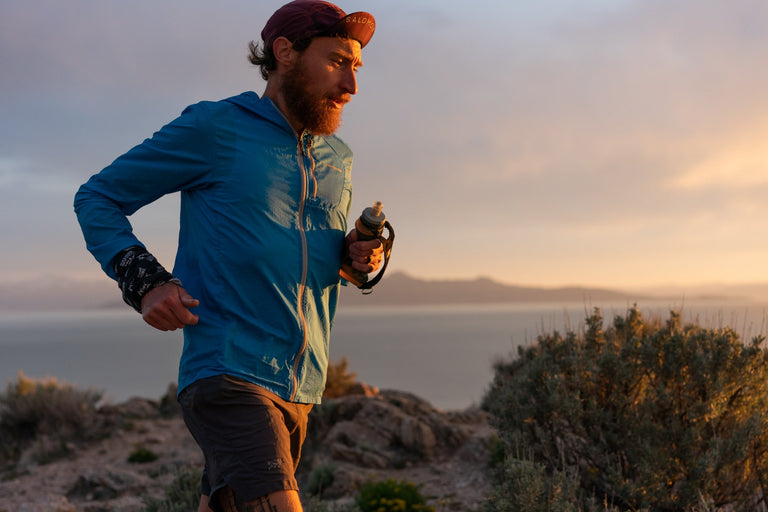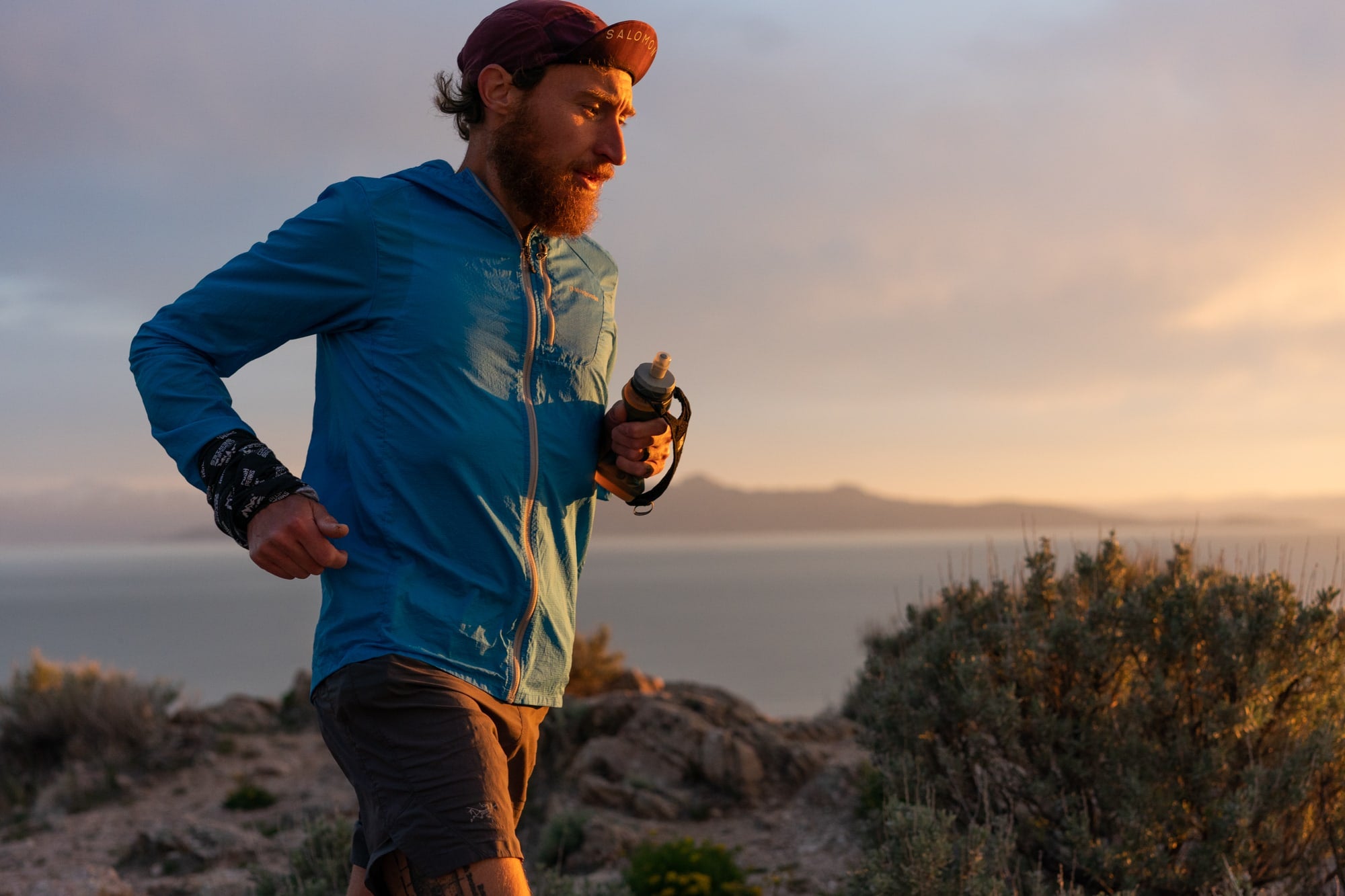Ultrarunner Trevor Fuchs dreamt of becoming a professional athlete when he was a child. Now 39, Trevor is an accomplished plant-based ultrarunner, having won the Wasatch 100 twice, winning the Hurt 100 in 2020 and setting a new FKT on Moab’s White Rim in November 2020, among other accomplishments.
But, with success comes new expectations, and a new reality to navigate. “Fuel for Life: Trevor Fuchs,” a film directed by Cam McLeod, illuminates Trevor’s personal reflection on the “why” behind his running career.

We went behind the scenes with Trevor and Cam to uncover more information about Trevor, the filming and screenwriting.
Cam, you knew of trevor and his running before this project, but had never met him personally. Describe the process of getting to know him while also creating a film.
One of my favorite things to do is to work with people or subjects that I don’t know much about. That really feeds into the process of doing the research and trying to learn more about this person, which makes it a pretty genuine interaction between myself and the subject.
I wasn’t familiar with Trevor’s story, which can actually be an advantage in these projects because it requires me to ask a lot of questions and learn about a person on the fly.
It is my job to listen as much as possible and to represent, as best as possible, people who are willing to share their story with me.
Trevor, when we first approached you with this project idea, you said you'd happily share anything we thought would be meaningful to our audience, but that you had some reservations. Tell us more about this.
A lot happened in 2020 that reframed my view on the sport, how I relate to running, and other people in that world.
The lines became blurred for what I understood some sponsors wanted from me or why they signed me in the first place – no matter what I did it didn’t feel like enough. It was difficult to get acknowledgement that I was on the right path. Part of it is that the responsibilities of social media aspects are time consuming and don’t always feel super authentic.
It all just felt fake for the entire year. I wasn’t getting any feedback and didn’t feel like I was actually a sponsored athlete. I just had this agreement and signed this paper and did all the things to meet the contract, but brands weren’t always doing the things promised on their end.
I felt a lot of disappointment because I thought big sponsorships would be something I could build on and be a cool step in my running career, but that was deflating for how it panned out.

How did the video' s narrative end up coming to fruition?
Cam:
I look at these projects as collaborations: I have a style, aesthetic and approach, but I try to share that process as much as possible with the people I’m working with, especially the subjects.
To get to the final, we went through a few different iterations. Originally, Trevor had provided a stream of consciousness writing which described his story and touched on his frustrations. This functioned as our base and we worked through the narrative from there. I didn’t want to impose my view on him and say, “This is what we are going to do.” I wanted this to be a collaboration and be true to Trevor’s story while crafting something thoughtful.
I quickly honed in on this idea that social media was a struggle for Trevor and that he was rethinking the role it played in his life. His frustration as an athlete with social media responsibilities is timely: as a person of influence through his brand partnerships, and the way social media is woven into our daily lives, I can relate to Trevor’s frustrations. I think most of us can and many of us are reevaluating the way we engage with these platforms.
Trevor:
A lot of the writing was definitely fueled by my sort of guilt about the priorities I had put in my life around running the past several years. I’ve watched my kids grow up, who are now 5, 6 and 13, and they have their own interests and hobbies that I haven’t been present in.
Cam:
Once we narrowed in on the concept, I took his thoughts and repackaged them into a script and then bounced it back and forth until we were happy with it. It basically functioned as a dialogue between him and I, and we got to know each other while working through the script.
This narrative is obviously a bit ironic, considering the piece is coming from a brand, in the end. But, you all pulled it off very well, and tastefully. What was it like navigating this aspect through visuals and the script?
Trevor:
Honestly, when Cam and I looked at what we were tasked with, I wasn’t sure I wanted to do this initially. I asked my wife her thoughts and she reminded me that the kids get a huge kick out of seeing anything about me in articles or videos and stuff.
She said that if I’m thinking about backing off from the sport because of how I am feeling, that maybe this is a good opportunity for them to watch and be proud of me.
When me and Cam were talking, I mentioned that, and he said we could almost make it a letter or gift to my kids, that I could tell them everything I wanted to, and that they might not understand now at 5 or 6, but they will in a few years.
Cam:
It was challenge. We were very aware of the looming contradiction, but recognized that it’s a contradiction that many athletes, content creators, and others are struggling with every day.
The question became, “How do we best represent that?” Trevor’s initial narrative felt like the struggle was something he was burdened with alone. It also felt like it was him vs sponsors and their expectations. However, the more we talked through it the more we realized that this struggle was more about individual priorities and doing the best we can as partners while keeping true to ourselves. It’s about finding that balance for ourselves and for Trevor the balance needed to be shifted back to family.
So I wanted to find a way to include Trevor’s family but keep the narrative from his perspective. I wanted one voice to carry the film. I had these visuals of a father reading to his kids and thought how could we capture that emotion. That got me thinking about structuring the film in a way that felt like a children’s book, which led me down the road of letter written to his family.
In the end, this could feel like anti-brand content, which was super interesting. It’s not something we wanted to create but not something we wanted to shy away from either. We were walking a tight rope but felt it was relevant. How do we represent a brand while representing ourselves? I don’t think those things need to be mutually exclusive. Trevor’s story shows the reality of this.
Cam, tell us about the visuals in the film.
We had environmental factors to consider. You can see in some of the photos some background peaks with snow – the Wasatch was covered in snow in higher elevations, so we couldn’t get up high. We also would’ve been restricted to shooting on the benches of the Wasatch Front. Those locations are on a hillside, so as far as camera angles and unique looks goes, you’re restricted to a two-dimensional plane. I wanted space to move around our subject . Antelope island presented the best opportunity to move in that way because you can shoot from multiple angles.

The island is the “Highlands” of northern Utah, it has that feel of Scotland. It’s iconic to Utah, but doesn’t feel like the Wasatch. Plus you have the buffalo, which we included in the film. … We really wanted the visuals to reflect that emotion of being dreamlike, almost fictional, to represent that “story time” feel.
We were also hard-pressed with time because we knew the no-see-ums would be out – we were racing those bugs.
We got destroyed the second day we were out there. We all walked away completely welted with them. I felt really bad for Trevor because he was in shorts and a sleeveless shirt getting destroyed, while I was in pants and a long sleeve shirt. He was a trooper.

Cam, how did your personal artistic approach influence the visuals and storytelling of this piece?
I didn’t want a film that was going to be reliant on visual continuity. I wanted the freedom to focus on beautiful visuals that could communicate a dream-like quality, something from the imagination or a memory. So we shot shot sunrise, sunset and blue hour. We shot mostly hand held which for me, reminds me of what my memories look like.
Blue hour, which occurs right after the sun goes down, creates a mood and drama that you just don’t get any other time of day.
Once we dialed in the narrative and it was this letter to his kids, we wanted to emphasize visuals that felt dreamy and imaginative. Shooting in these times helped us do this. And we decided to shoot handheld, especially when with his family, to build a certain level of intimacy.
Trevor, in the video, you say running is a way for you to check in with yourself. What do you mean by this?
Mostly that I don’t give myself time throughout the day to really process much. We’re just so flooded with information all the time, and I’m not really good at opening multiple boxes in my brain at once.
When I’m running I can dive into all the challenges or ideas I’ve been presented or have, or words I’m trying to get out – anything like that I can really just get inside my head and have more time to think.
Ultimately, it balances me out a lot. If I didn’t have that outlet then I don’t know when I would find time to let those things happen. My brain would always be a jumbled mess.
Watch the full film!
You also hint at the fact that running fuels your “emotional tank” and allows you to be present for those that are most important in your life. Can you expand on this?
I don’t know that I’ve ever really struggled with serious mental health issues. But I’ve been through things, like a divorce, and anytime I’ve really struggled through things, running is almost like therapy without having to talk to anybody. It’s hard to explain, and part of that is getting lost in your thoughts.
There’s confidence boosting that happens with running, just feeling good as far as fitness and health. A lot of that adds up to having balance in your life, no matter what is going on.
What has been your personal solution to the dilemma that you describe? Have you turned away from sponsorships as a whole? Turned away from social media?
Yea, I’ve stepped away fully from social media. And I declined my renewal with a different brand, and told a few others I’ve been stepping away, which includes Gnarly. Not that I won’t continue to use the products, I just don’t want to accept anything anymore. I want to pay for everything from now on because I think it keeps the sport in perspective for me.
I think being given things, for one, adds a lot of expectations, at least perceived on my end. It makes me feel like I have to do certain things. Also, I realized I don’t want to make this a career, more-so like something out of passion.
What is your next move, then?
Obviously I’ll still run for my own well-being and mental health, but I need to be there for my kids and I can’t just be like, “sorry I can’t come to your t-ball game because I have to run for two hours.”
I’m going to focus on my kids and run later in the evening when my kids are asleep, and switch my focus more to them and not what I’m doing. I’ve had 40 years to figure my life out, now it’s time to figure out theirs.
How would you describe your “fuel?”
I think it’s trying to explore my personal capabilities and really find out what I can do and who I am. When things really start to suck, what can I overcome?
That’s the biggest thing, especially with 100 milers. When you find yourself in a dark place and can’t remember why you do this … how do you pull yourself out? And then reflecting on that after. It makes me realize that hard thighs really aren’t that hard, and I can get through just about anything.
That’s ultimately what fuels me: finding that feeling of being able to overcome anything.
What would you tell others who are on the path, or have dreams to become, a professional athlete, and who may be feeling similarly to how you do?
I would just say: Don’t stop pushing yourself to be the best you can be. And don’t feel like you need to create a persona of yourself that may or may not be factual.
We all know social media is a tool to show people good times. Occasionally athletes and people show bad things, but I think sometimes even that is embellished. I think being fully true to yourself is sometimes being mundane and not worth viewing or watching or reading.
Sometimes we’re just hanging out in the park and making sure our kids don’t hurt themselves jumping off the swings. It’s okay to embrace the fact that life is not as exciting as we feel like we have to make it seem for other people. If that isn’t going to sell a product or “influence,” then so be it.
Cam, in your limited time collaborating with him, how would you describe Trevor?
I think Trevor is an extremely humble, driven person who holds himself to a high standard. I think he’s very thoughtful, and thinks a lot about his family and himself, not in a selfish way, but in the context of what’s going around him, and how he can be the best person he can be.
Are there any last comments you'd like to make?
Cam:
People are becoming aware of the disingenuous world of marketing, especially that related to influencer marketing. I think it is important to continue to uplift people’s stories and be intentional with who you partner with both as a brand and as an ambassador. I hope brands start supporting people instead of seeing people as a means to an end as an extension of their marketing platform. It can be such a mutually benefiting relationship when approached that way.
We talk a lot about “authenticity”, especially in the outdoor industry, but more often than not, that’s not what we get and that’s not what we see. Being authentic is hard and means taking a position that might challenge others.
To acknowledge Gnarly: You could have easily said no, and wanted to really brand this piece. But you gave us latitude to play in this space.
I think this shows that there is a responsibility to not just the athlete’s arena for upholding values to a brand, but it is a brand’s responsibility to also uphold values of person, and allowing that person to be a person and not just an influencer in some capacity. I appreciate it when brands highlight real people with real stories.
At the end of the day, it was a fun project to work on. I really enjoyed the challenge of telling Trevor’s story because I thought it was relevant and it can resonate with a lot of people.
Trevor:
I’d like to say thank you for the opportunity to do this.
When we first talked about the project, I mentioned I don’t want to do anything anymore relating to content for other brands. But this topic was kind of a risk, so thanks for taking a chance on me and this story.




